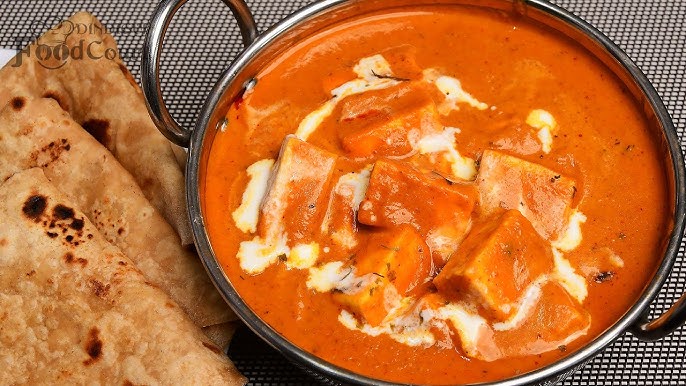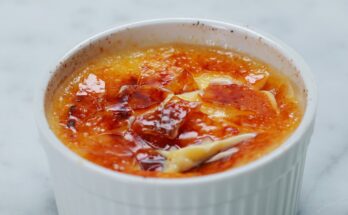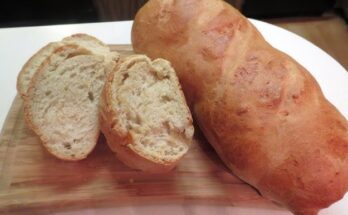Paneer Butter Masala Recipe: Paneer Butter Masala—just the name itself makes your mouth water! It’s one of the most beloved dishes in Indian cuisine, known for its rich, creamy, and mildly spiced tomato-based gravy that perfectly coats every soft cube of paneer. Whether you’re eating it with naan, roti, or fragrant basmati rice, this dish delivers comfort and indulgence in every bite.
This recipe is the epitome of North Indian restaurant-style cooking, but the best part is that you can easily make it at home with simple ingredients. It’s perfect for special occasions, family dinners, or even a cozy weekend treat. The combination of butter, cream, and aromatic spices creates a symphony of flavors that never fails to impress.
In this complete step-by-step guide, we’ll walk you through everything you need to make the perfect Paneer Butter Masala—from selecting ingredients to achieving that silky-smooth texture just like your favorite restaurant. So, tie on your apron and get ready to bring some restaurant magic into your kitchen.
The History Behind Paneer Butter Masala
Paneer Butter Masala, also known as Butter Paneer or Paneer Makhani, originated in the heart of North India—specifically from the food capital, Delhi. It is believed to have been first created in the kitchens of the famous Moti Mahal restaurant during the 1950s. The chefs there were already known for inventing Butter Chicken, and soon after, they crafted a vegetarian counterpart using paneer instead of chicken.
The recipe was designed to appeal to vegetarians who wanted to experience the same rich and creamy taste as Butter Chicken. Over time, the dish evolved to include more refined ingredients and techniques, becoming a staple in both home kitchens and high-end restaurants across India.
What makes Paneer Butter Masala timeless is its adaptability. Every household adds its own touch—some make it richer with extra butter, while others prefer a lighter version with less cream. Despite variations, the soul of the dish remains the same: a smooth, buttery tomato gravy that makes every bite unforgettable.
Why Paneer Butter Masala is So Popular
There’s a reason why Paneer Butter Masala is featured on almost every Indian restaurant menu—it’s a crowd favorite! The dish is a perfect harmony of flavors—sweet, tangy, and mildly spicy. The buttery, creamy sauce makes it appealing to all age groups, even to those who aren’t fans of spicy food.
One of the main reasons for its popularity is versatility. Paneer Butter Masala pairs beautifully with almost everything—naan, chapati, paratha, or rice. It’s comforting, rich, and satisfying, making it suitable for both festive occasions and simple family dinners.
Additionally, paneer (Indian cottage cheese) itself is a powerhouse of protein, which makes this dish not only delicious but also nutritious. Unlike other heavy curries, Paneer Butter Masala doesn’t rely on too many spices. Instead, it celebrates balance—the tang of tomatoes, the creaminess of cashews and cream, and the silkiness of butter.
Whether you’re new to Indian cooking or a seasoned chef, mastering Paneer Butter Masala is a must. It’s the kind of dish that earns compliments, brings people together, and never goes out of style.
Ingredients You’ll Need
Before we dive into the cooking process, let’s get our ingredients ready. Here’s everything you’ll need to make a rich, restaurant-style Paneer Butter Masala at home:
Main Ingredients
- Paneer (Cottage Cheese) – 250 grams, cut into cubes
- Butter – 2 tablespoons (preferably unsalted)
- Oil – 1 tablespoon
- Onion – 1 medium, chopped
- Tomatoes – 3 large, roughly chopped
- Cashew Nuts – 10–12 pieces (soaked in warm water)
- Garlic – 4 cloves
- Ginger – 1-inch piece
- Green Chili – 1, slit
- Fresh Cream – 3 tablespoons
- Water – as needed
Spices
- Red Chili Powder – 1 teaspoon
- Turmeric Powder – ¼ teaspoon
- Coriander Powder – 1 teaspoon
- Garam Masala – ½ teaspoon
- Salt – to taste
- Kasuri Methi (Dried Fenugreek Leaves) – 1 teaspoon, crushed
Optional Ingredients for Extra Flavor
- Honey or Sugar – ½ teaspoon (to balance acidity of tomatoes)
- Cardamom Powder – ¼ teaspoon (for fragrance)
- Bay Leaf – 1 (for aroma during sautéing)
Ingredient Substitutions
- Don’t have cashews? Use almonds instead for a slightly nutty twist.
- If you’re vegan, replace butter with vegan butter or coconut oil, and cream with coconut milk.
- Store-bought tomato puree can work in place of fresh tomatoes, though the flavor will be slightly tangier.
Having all ingredients prepped before starting makes the cooking process smoother and more enjoyable. Think of it as setting the stage before the performance begins.
Essential Equipment Required
Cooking Paneer Butter Masala doesn’t need fancy gadgets, but having the right tools will help you achieve that restaurant-like consistency and flavor.
Here’s what you’ll need:
- Heavy-bottomed pan or kadhai: Prevents burning and helps in even cooking.
- Blender or mixer grinder: For making the smooth tomato-cashew puree.
- Wooden spoon or spatula: To stir the gravy without scratching your pan.
- Measuring spoons: To keep the spice proportions perfect.
- Knife and chopping board: For prepping your ingredients efficiently.
- Bowl for soaking nuts: Makes cashews soft and easier to grind.
Pro Tip: Use a non-stick pan if you’re new to Indian cooking—it helps manage the rich, buttery gravy without sticking or burning.
Step-by-Step Guide to Make Paneer Butter Masala
Now that we’ve gathered all our ingredients and tools, it’s time to dive into the cooking process. Making restaurant-style Paneer Butter Masala at home may seem complex, but if you follow these steps carefully, you’ll have a perfectly creamy, flavorful dish that rivals any restaurant.
Step 1: Preparing the Ingredients
Preparation is the secret to any great dish. Start by cutting the paneer into medium-sized cubes. If your paneer feels hard or rubbery, soak it in warm water for 10 minutes—this keeps it soft and spongy.
Next, chop your onions, tomatoes, garlic, and ginger. Soak cashew nuts in warm water for at least 15 minutes to soften them—this ensures a smooth gravy later. Gather all your spices—red chili powder, turmeric, coriander powder, and garam masala—so you don’t scramble during cooking.
Step 2: Making the Tomato-Cashew Base
Heat 1 tablespoon of oil and 1 tablespoon of butter in a pan over medium heat. Once hot, add chopped onions and sauté until they turn golden brown. Add ginger, garlic, and green chili, and sauté for another minute until fragrant.
Now add chopped tomatoes and cook until they turn soft and mushy. Toss in the soaked cashews and a pinch of salt. Continue cooking for 5–7 minutes, stirring occasionally, until everything blends together beautifully.
Turn off the heat and let this mixture cool slightly. Transfer it to a blender and blend into a smooth, silky puree. If it’s too thick, add a splash of water. This is the luscious base that gives Paneer Butter Masala its signature richness.
Step 3: Cooking the Gravy
In the same pan, heat the remaining butter. Add the tomato-cashew puree and let it simmer for 2–3 minutes on low heat. You’ll notice it spluttering a bit—cover the pan lightly if needed.
Now, add all your spices—red chili powder, turmeric, coriander powder, and garam masala. Mix well to combine and cook for 5–7 minutes, stirring occasionally, until the oil starts separating from the masala. This is a sign that your gravy base is perfectly cooked.
If the mixture feels too thick, add ½ cup of warm water (or milk for a richer texture). Stir continuously until you achieve a creamy consistency.
Step 4: Adding Paneer Cubes
Once your gravy is bubbling and fragrant, gently add the paneer cubes. Stir carefully so they are coated evenly with the gravy. Simmer for 3–5 minutes on low heat—avoid overcooking, as paneer can become chewy.
To balance the flavors, you can add ½ teaspoon sugar or honey. This cuts through the tanginess of tomatoes and enhances the buttery richness.
Step 5: Final Touches with Cream and Butter
Now for the finishing touch—stir in 3 tablespoons of fresh cream and ½ teaspoon of crushed kasuri methi. Mix gently and simmer for another minute. You’ll see the gravy transform into a velvety, restaurant-style texture.
Switch off the flame and add a small dollop of butter on top before serving. The aroma is irresistible—creamy, buttery, and utterly divine!
Pro Tips for the Perfect Paneer Butter Masala
Making the perfect Paneer Butter Masala isn’t just about following a recipe—it’s about mastering little techniques that elevate the dish to restaurant quality. Here are some expert tips:
- Use Fresh Paneer: Always use fresh, soft paneer for the best texture. If using store-bought paneer, soak it in warm water before adding it to the gravy to make it tender.
- Roast the Masala Well: Cook your onion-tomato-cashew mixture until the oil starts separating. This is key for rich, deep flavor.
- Don’t Skip the Cashews: Cashews are what make the gravy creamy and luscious. If you prefer a lighter version, use almonds—but don’t omit nuts entirely.
- Balance the Flavors: The tanginess of tomatoes, the sweetness of cream, and the spice from chili powder should all complement each other. Taste and adjust seasoning before finishing.
- Use Butter and Oil Together: Butter gives flavor while oil prevents it from burning—using both ensures perfect balance.
- Kasuri Methi Is the Game-Changer: Adding crushed kasuri methi at the end brings that authentic restaurant-style aroma and taste.
- Blend Smoothly: Always blend the tomato-cashew mixture into a fine puree for a silky-smooth gravy.
- Add Cream Last: Cream should be added at the end and simmered lightly. Boiling it can cause it to curdle.
Follow these tips, and you’ll serve Paneer Butter Masala that looks and tastes just like it came from a 5-star restaurant.
Common Mistakes to Avoid
Even seasoned cooks can make small errors that affect the taste or texture of Paneer Butter Masala. Here’s what to watch out for:
- Overcooking the Paneer: Paneer only needs a few minutes in the gravy. Overcooking makes it rubbery and tough.
- Using Raw Tomato Puree: Always cook your tomatoes thoroughly before blending. Raw puree makes the gravy tangy and undercooked.
- Skipping the Cashew Step: Blending cashews properly is crucial. Unsoaked or under-blended nuts lead to a grainy texture.
- Not Balancing Spices: Too much chili powder can overpower the delicate flavor of butter and cream. Remember, this dish is mildly spiced.
- Adding Cream Too Early: Adding cream while the gravy is still boiling can cause it to split. Always lower the heat before stirring it in.
- Not Using Butter Generously: It’s called “Butter Masala” for a reason! Skimping on butter will make the dish lack richness.
- Neglecting Kasuri Methi: This humble ingredient adds depth, aroma, and authenticity—don’t skip it.
Avoiding these common pitfalls ensures that your Paneer Butter Masala turns out rich, smooth, and flavorful every time.
Serving Suggestions
Paneer Butter Masala is incredibly versatile and pairs beautifully with various Indian breads and rice dishes. Here are some of the best ways to enjoy it:
- With Naan: The soft, buttery naan is perfect for scooping up that rich gravy.
- With Roti or Chapati: For a lighter, more homely meal, serve it with whole wheat roti.
- With Paratha: Flaky parathas add a delicious texture contrast to the creamy curry.
- With Steamed Basmati Rice: The subtle aroma of basmati complements the flavors perfectly.
- With Jeera Rice: The slight spice from cumin rice adds another layer of flavor.
Garnishing Ideas
- A swirl of fresh cream on top.
- Sprinkle chopped coriander leaves for color and freshness.
- A small pat of butter melting on the hot curry just before serving.
Pairing Drinks
- Mango Lassi or Sweet Lassi to balance the richness.
- Masala Chaas (Spiced Buttermilk) for a refreshing, light option.
With these combinations, every bite feels like a complete, satisfying meal that leaves you wanting more.
Nutritional Value
Paneer Butter Masala may be indulgent, but it’s also packed with nutrition when consumed in moderation. Here’s a quick breakdown of its nutritional profile per serving (approx. one medium bowl):
| Nutrient | Amount (Approx.) |
|---|---|
| Calories | 380–420 kcal |
| Protein | 15–18 g |
| Carbohydrates | 12–15 g |
| Fat | 32–35 g |
| Fiber | 2 g |
| Calcium | 25% of daily value |
Health Aspects:
- Paneer provides a great source of protein and calcium, supporting muscle growth and bone strength.
- Cashews contribute healthy fats and a creamy texture.
- Tomatoes are rich in antioxidants and vitamin C.
- Butter and cream, though rich in fat, give energy and flavor—ideal for occasional indulgence.
Enjoy it as part of a balanced diet, and you’ll get both taste and nourishment in one dish.
Variations of Paneer Butter Masala
One of the best things about Paneer Butter Masala is how adaptable it is. You can easily tweak the recipe to suit your dietary preferences, spice tolerance, or even the ingredients you have on hand. Here are some delicious variations worth trying:
1. Vegan Paneer Butter Masala
If you’re following a vegan diet, don’t worry—you can still enjoy this creamy delight. Simply replace paneer with tofu or firm vegan cheese. Swap butter with vegan butter or coconut oil, and use coconut cream or cashew cream instead of dairy cream. The result? A dairy-free version that’s just as rich and flavorful.
2. Low-Fat Paneer Butter Masala
Want to cut down on calories? Use low-fat paneer, skip the cream, and substitute it with blended yogurt or milk. You can also reduce the amount of butter and oil without sacrificing much flavor. For extra creaminess, add a tablespoon of almond paste instead of cream.
3. Spicy Version
Love bold flavors? Double the amount of red chili powder or add a pinch of black pepper for a stronger kick. You can also toss in one slit green chili while simmering the gravy to intensify the heat.
4. Restaurant-Style Paneer Butter Masala
If you’re aiming for that authentic, luxurious restaurant feel, use fresh tomato puree, lots of butter, and full-fat cream. Also, finish it off with a drizzle of ghee (clarified butter) for added aroma and richness.
5. Nut-Free Version
For those with nut allergies, skip cashews and instead use sunflower seeds or melon seeds (magaz) for a similar creamy texture. You can also thicken the gravy slightly with boiled and blended potatoes—a clever, allergen-free alternative.
Each of these variations keeps the heart of the dish intact while allowing you to make it your own. Whether you want it rich, spicy, vegan, or low-fat, Paneer Butter Masala can easily adapt to your taste.
Storage and Reheating Tips
You’ve made a delicious batch of Paneer Butter Masala—now what if there’s some left over? The good news is that it stores beautifully and tastes even better the next day when the flavors deepen. Here’s how to store and reheat it properly:
Refrigeration
- Let the curry cool completely before storing.
- Transfer it to an airtight glass or steel container.
- Store in the refrigerator for up to 3 days.
- Reheat in a pan over low flame, adding a splash of water or milk to bring back the creamy consistency.
Freezing
- Paneer Butter Masala freezes well for up to 2 months.
- Use freezer-safe containers or zip-lock bags.
- When you’re ready to eat, thaw overnight in the refrigerator and reheat on the stove.
- Avoid microwaving directly from frozen—it can make the paneer rubbery.
Pro Tip:
If you plan to freeze, it’s best to store the gravy and paneer separately. When reheating, add the paneer freshly to preserve its texture and softness.
By following these tips, you’ll always have a comforting, homemade Indian meal ready to enjoy without any compromise in flavor.
Health Benefits of Paneer Butter Masala
Though often considered a rich and indulgent dish, Paneer Butter Masala offers several surprising health benefits when enjoyed in moderation. Let’s break them down:
1. Rich Source of Protein
Paneer, the star of the dish, is an excellent source of protein, especially for vegetarians. A single serving provides around 15–18 grams of protein, supporting muscle growth, tissue repair, and energy levels.
2. Strengthens Bones and Teeth
Paneer is packed with calcium and phosphorus, both essential for strong bones and teeth. Regular consumption in moderation can support bone density and prevent deficiencies.
3. Provides Healthy Fats
While butter and cream may sound heavy, they contain good fats that help in nutrient absorption and keep you satiated. They also contribute to a radiant skin texture when consumed responsibly.
4. Boosts Energy
The combination of paneer, butter, and cream makes Paneer Butter Masala energy-dense, providing quick fuel for the body—perfect for those with active lifestyles or athletes needing extra calories.
5. Supports Digestion and Immunity
The spices used—like turmeric, ginger, and garlic—have natural anti-inflammatory and antioxidant properties. They not only enhance flavor but also promote digestion and strengthen immunity.
6. Contains Antioxidants
Tomatoes are rich in lycopene, an antioxidant known for protecting against heart disease and improving skin health. Combined with healthy fats, the absorption of lycopene becomes even more effective.
7. Good for Vegetarians
For those who avoid meat, Paneer Butter Masala provides essential nutrients like vitamin B12, iron, and magnesium—all crucial for maintaining overall health.
So while it’s a rich dish, Paneer Butter Masala can be part of a balanced diet. Enjoy it occasionally with whole wheat bread or brown rice for a wholesome, satisfying meal.
FAQs about Paneer Butter Masala Recipe
1. Can I use frozen paneer for this recipe?
Yes! Just thaw it completely and soak it in warm water for 10–15 minutes before cooking. This restores its softness and makes it taste fresh.
2. How do I make the gravy smoother?
Blend the tomato-cashew mixture very well until it’s silky. Strain it through a fine sieve if you want that ultra-smooth restaurant-style texture.
3. Can I skip cashews to make it lighter?
Yes, but replace them with almonds or a tablespoon of yogurt for creaminess. Cashews, however, provide the classic texture and taste.
4. What’s the difference between Paneer Butter Masala and Shahi Paneer?
Paneer Butter Masala uses a tomato-based gravy with cream and butter, while Shahi Paneer is richer, made with nuts, yogurt, and spices, giving it a sweeter and heavier profile.
5. Why is my gravy too tangy?
Overly sour tomatoes or too much puree can make the dish tangy. Add a bit of sugar, honey, or extra cream to balance the flavors.
Conclusion
From selecting the right ingredients to following each step carefully, making Paneer Butter Masala at home is an experience worth savoring. And once you’ve mastered it, you’ll never feel the need to order it from a restaurant again—because your homemade version will taste even better!
So go ahead, put on your apron, grab your ingredients, and bring the magic of Indian cuisine to your kitchen today.



